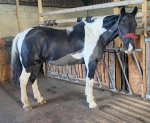spotty_pony
...
As title. I am going to have a chat with my vet in the morning about this. To cut a very long story short my ISH has tears to both DDFT In in his hooves with lesions forming and swelling in the navicular bursae. He spent the day at Rossdales in June where he had an MRI, was remedially shod and had the navicular bursae injected. He was doing really well, had two weeks off and we started walk work and built from there and started trotting at the end of August, all in straight lines and only trotting on a suitable surface off road (which wr xannto do now due to the ground so we are back to walk work only). Recently he takes one lame step when he comes out of the stable in the morning and is very slightly off when trotted up but Vet said so slight you would only know if you knew him before the issues started. I have been reading with interest the benefits of barefoot rehab for this type of injury and the success rate is quite high so I am considering taking his shoes off. He is currently only shod in front anyway.
Just wondering if anyone had any experience with this and has any advice? Got to convince my farrier yet that it's the right thing to do too..!
Just wondering if anyone had any experience with this and has any advice? Got to convince my farrier yet that it's the right thing to do too..!

